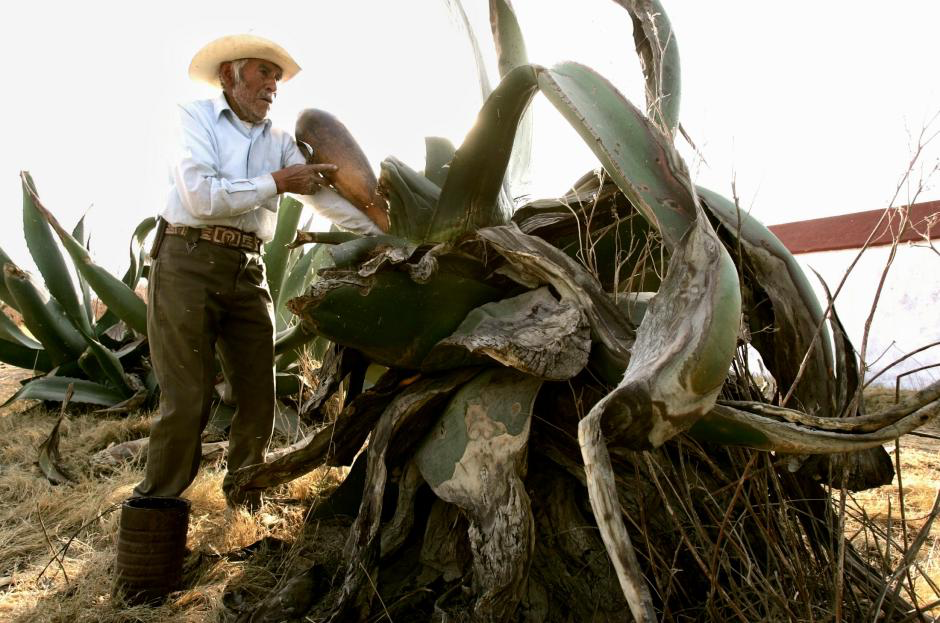Posted: Dec 16, 2017

Three types of alcoholic beverages can be made from the spidery agave plant: mezcal (distilled from the heart of the plant), tequila (the best-know type of mezcal, which originates from the city of Tequila), and the lesser-known pulque (a milky, viscous beer-like beverage made from fermented sap). While the US tequila market—the biggest in the world—has surged 65% between 2005 and 2015, pulque is making a slow renaissance in both Mexico and abroad. Mexico’s groovy young things are increasingly loving pulque’s indigenous heritage, health benefits (no hangover involved, and a decent source of nutrients), and sweetened, cocktail-like flavors.
Among the indigenous people of Latin America one millennium ago, pulque was known as the “drink of the gods.” The best pulque took decades to ferment, and was drunk by Aztec nobility and priests during religious festival and victory celebrations. Commoners were not permitted to imbibe pulque, except for pregnant women and the elderly due to its vitamin content and low levels of alcholol. But when the Spanish colonized Mexico, they wanted to stamp out the drink.
“Pulque was seen as a corrupting influence on indigenous populations,” Daniel Nemser, assistant professor of Spanish at University of Michigan, told travel journalism site Roads and Kingdoms. “The Spanish thought it was disgusting, and they wanted to get rid of it.”
Extracting the sap, which can take almost an entire decade to mature, from the agave cactus plant.
By the twentieth century in Mexico City, European beer had replaced pulque as the drink for relaxing and socializing. Aided by the government, the beer industry was heavily invested in promoting itself—while playing up pulque’s stigma of being associated with Mexico’s lower-class and indigenous populations. In fact, Dr. José Siurob Ramírez, who was head of Mexico’s Department of Public Health and a military general during the Mexico Revolution (1910–1920), considered erdicating the beverage to be one of the most important goals of the Revolution.
“German brewers came into Mexico with big modern factories in the late 19th century,” Rachel Laudan added. “There was this argument, a calculated campaign to discredit pulque, really, saying that beer was a scientifically produced, European drink, while pulque was backward and unhygienic, that excrement was used to ferment it.” That campaign was propaganda, of course—and denied the strong role pulque played in both Mexican nutrition and daily life. According to a 1946 medical study of 100 people, “daily intake of pulque (up to 2 L) provides calories (12%), total protein (6%), thiamin (10%), riboflavin (24%), niacin (23%), vitamin C (48%), calcium (8%), and iron (51%).”
Despite the attempts kill off pulque, the drink is having a resurgence. In the the past decade, over 100 pulquerías—pubs that specialize in pulque—have erupted across Mexico City. And it’s not just old, nostalgic folks enjoying the cheap beverage of their youths. Young urban elite, millennials, hipsters, whatever nomenclature you prefer, are flocking to these stylish, dive bar-like taverns like the 105-year-old Pulquería Duelistas for flavored pulque drinks (like mango or pistachio). Pulque is enjoying a Pabst Blue Ribbon-like renaissance among young people who want to reclaim their indigenous roots.
“I like this because it is something we inherited from our ancestors and because my family also drinks it,” said Gallardo Leon, a 20-something Mexico City resident drinking at Dualistas, told the Seattle Times. “It’s something we shouldn’t lose.”It’s also being sold as a health beverage, an edgier version of kombucha. Even edgy gastro-adventurer Anthony Bourdain is giving pulque its due, calling it “Mexican Viagra” (video).
A pulque vendor with various flavors for sale at a pulque celebration in Santiago Cuautlalpan, Mexico.AP Photo/Marco Ugarte
A pulque vendor with various flavors for sale at a pulque celebration in Santiago Cuautlalpan, Mexico.
Unlike tequila and mezcal, though, local, home-based makers are still producing the bulk of pulque. For one, it has a short shelf life, and at reputable pulquerías, leftover batches are discarded at the end of the day. Secondly, the sweet agave sap, aguamiel, can take up to 7 years to reach maturity—far longer than the raw materials used for wine (grapes) or beer (grains). In order to pasteurize it for exportation, mass-market pulque is heat-treated, which leaves it tasting like juice that has been sitting out in the sun for too long. Fresh pulque should taste like beer-meets-yogurt-meets-juice. Or as Quartz reporter Ana Campoy describes it, “almost like drinking liquid boogers.” (It’s thick and mucus-y.)
In New York City, where I live, there is a restaurant-slash-bar called Pulquería, opened in 2011, which sells a canned version of the drink, though you wouldn’t know because it is poured into a glass, and besides, you may not have had the fresh version unless you’ve been in Mexico. Pulque is acquired taste, but it’s been around for over 1,000 years and has survived temperance movements and propaganda campaigns. It’s not going anywhere.
By Noël Duan
December 14, 2017
Source and Image Credits: Quartz.qz.com
Go-Wine's mission is to organize food and beverage information and make it universally accessible and beneficial. These are the benefits of sharing your article in Go-Wine.com


The Wine Thief Bistro & Specialty Wines is a locally owned small business in downtown Frankfort, IL offering world class wines in a relaxed, casual gathering spot for friends and family. Offering world class virtual tastings and touchless carryout.
https://www.twtwineclub.com/aboutus
Go-Wine 25 Great Wineries in US selection prioritizes quality, value and availability.
www.go-wine.com/great-wineries-in-america
Tasting wine is a nice experience, but visiting the places in which wine is made is a magic moment. Available in New York City for touchless pickup.